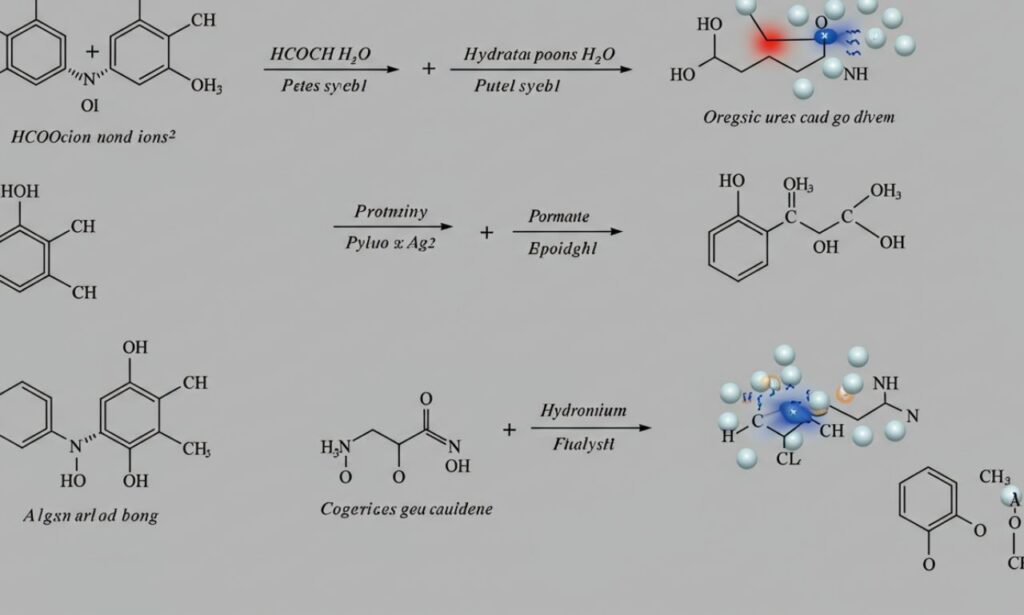HCOOCH CH2 H2O represents an interesting combination in organic chemistry. This notation can indicate formate esters reacting with methylene groups in the presence of water. Understanding this reaction is crucial for students, researchers, and chemical engineers because it helps explain key synthesis processes and industrial applications.
This article explores the structure, reaction mechanism, and uses of HCOOCH H2O in research and industry. We will also look at its role in chemical synthesis and why scientists are revisiting such reactions in the context of green chemistry.
HCOOCH CH2 H2O – Structure and Formula
HCOOCH refers to a formate ester functional group, a derivative of formic acid (HCOOH) where the hydrogen is replaced by an alkyl or aryl group. CH2 indicates a methylene group, and H2O stands for water. When these components are part of a chemical equation, they typically describe hydrolysis or esterification reactions depending on the direction of the process.
-
HCOOCH: Represents the formate functional group.
-
CH2: Serves as a linking methylene group in many organic molecules.
-
H2O: The universal solvent, crucial for hydrolysis and hydration reactions.
Understanding the structural relationship between these elements helps chemists predict the products of their reactions.
HCOOCH CH2 H2O – Reaction Mechanism
Step 1: Activation of the Ester Group
In acidic or basic conditions, HCOOCH is activated for a nucleophilic attack by water molecules.
Step 2: Nucleophilic Attack
The lone pair on the oxygen atom of H2O attacks the carbonyl carbon of HCOOCH, forming a tetrahedral intermediate.
Step 3: Breakdown of Intermediate
The intermediate rearranges, breaking the ester bond and forming either formic acid or its salt (depending on pH).
Step 4: Formation of Products
The final step produces formic acid and an alcohol or other derivative depending on the CH2 substituent group.
This mechanism illustrates how water plays a central role in hydrolysis, a reaction fundamental to many biochemical and industrial processes.
HCOOCH CH2 H2O – Applications
1. Industrial Organic Synthesis
This reaction is widely used in the preparation of intermediates for pharmaceuticals, fragrances, and polymers.
2. Green Chemistry
Using H2O as a reagent aligns with sustainable chemistry principles, making this reaction more environmentally friendly than those using harsh solvents.
3. Biochemical Pathways
Formate derivatives are crucial in metabolism. Studying their hydrolysis helps researchers understand biochemical energy cycles.
4. Catalyst Development
Researchers experiment with catalysts that accelerate the HCOOCH CH2 reaction under mild conditions, improving energy efficiency.
HCOOCH CH2 H2O – Role in Polymer Chemistry
In polymer science, methylene groups act as repeating units, and ester hydrolysis affects polymer degradation rates. The HCOOCH CH2 system is studied to design biodegradable plastics and other eco-friendly materials.
Experimental Conditions for HCOOCH CH2 H2O
To study this reaction effectively, chemists control parameters such as:
-
pH Level: Acidic medium accelerates ester hydrolysis.
-
Temperature: Higher temperature increases reaction rate.
-
Catalyst: Enzymes or mineral acids speed up the conversion.
-
Concentration: Correct stoichiometric ratio ensures complete reaction.
HCOOCH CH2 H2O – Safety Considerations
Although this reaction is relatively safe, chemists take standard precautions:
-
Work in a fume hood to avoid inhaling vapors.
-
Wear protective gloves and goggles.
-
Store reagents properly to avoid unwanted side reactions.
Future Research on HCOOCH CH2 H2O
Researchers are focusing on:
-
Biocatalysis: Using enzymes for selective hydrolysis.
-
Renewable Feedstocks: Sourcing HCOOCH from biomass.
-
Energy Efficiency: Reducing energy consumption in large-scale synthesis.
These developments will make HCOOCH CH2 reactions more sustainable and cost-effective.
Key Takeaways
-
HCOOCH CH2 H2O describes a system where esters react with water.
-
The reaction mechanism involves nucleophilic attack and ester bond cleavage.
-
Applications range from industrial synthesis to green chemistry solutions.
Conclusion
The HCOOCH CH2 reaction highlights the fundamental role of ester hydrolysis in organic and industrial chemistry. By understanding its mechanism, chemists can predict products, optimize synthesis pathways, and design greener, more sustainable processes. Its applications extend from pharmaceutical production and polymer science to biocatalysis and biodegradable material development, showing its relevance across multiple fields.







